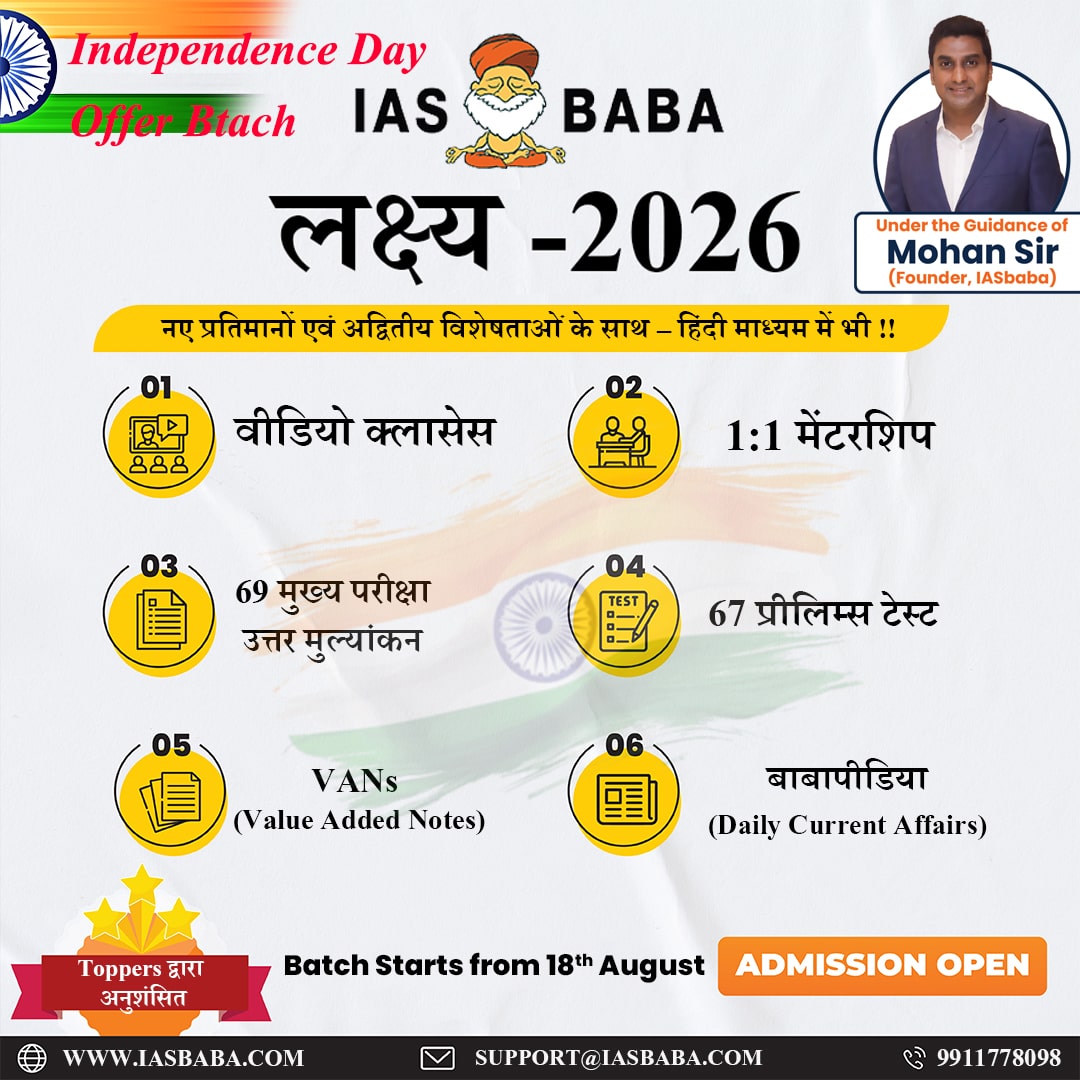IASbaba's Daily Current Affairs Analysis
Archives
(PRELIMS Focus)
Category: POLITY
Context: The next nationwide census of India, which was originally due in 2021 but repeatedly postponed due to the COVID-19 pandemic, is now scheduled to conclude by March 1, 2027
The government has announced that the census will be conducted in two phases, similar to previous exercises, and will include caste enumeration for the first time since 1931.
For snow-bound and non-synchronous regions such as Ladakh, Jammu and Kashmir, Himachal Pradesh, and Uttarakhand, the reference date will be October 1, 2026, with data collection starting earlier in these areas. The official notification outlining these reference dates is expected to be published in the official gazette on June 16, 2025, as per the Census Act, 1948.
The census process is expected to begin in earnest in early 2026, with the first phase involving house listing and the second phase focusing on population enumeration—both to be completed before the reference date of March 1, 2027. This census is highly significant as it will provide up-to-date demographic, social, and economic data, influence electoral boundary delimitation, and serve as the basis for implementing new policies, including women’s reservation in legislatures.
Learning Corner:
History of Census in India
The Census of India is one of the world’s largest administrative exercises, providing comprehensive demographic, social, and economic data. Its history dates back to the colonial period.
Early Attempts (Pre-1872)
- Sporadic population counts were conducted in various parts of India by British administrators, but they were not systematic or nationwide.
- The first such effort was in 1687–1688 by Governor Aungier in Bombay.
- Later, some provincial censuses were attempted in Madras (1822) and Punjab (1855).
First Systematic Census – 1872
- A more organized attempt was made in 1872 under Viceroy Lord Mayo.
- It was not conducted simultaneously across India, but it laid the foundation for future censuses.
First Synchronous Census – 1881
- The first synchronous and modern census was conducted in 1881 under W.C. Plowden (Census Commissioner of India).
- It is considered the first complete census of India, covering all regions simultaneously with standardized methodology.
Decadal Practice
- Since 1881, a decadal (every 10 years) census has been conducted without interruption, even during wars and emergencies.
- Each census has built on previous data, refining questions and methodology.
Post-Independence Censuses
- After independence in 1947, India continued the decadal census tradition under the Registrar General and Census Commissioner of India (established in 1949).
- The first post-independence census was held in 1951, which also helped in planning India’s Five-Year Plans.
Recent Censuses
- The 2011 Census was the 15th National Census and the 7th after Independence.
- It provided data on population, literacy, urbanization, language, disability, migration, and more.
- The 2021 Census has been delayed due to the COVID-19 pandemic, marking the first such delay in over 140 years.
Significance
- The Census provides a foundation for policymaking, resource allocation, planning welfare schemes, and electoral processes (e.g., delimitation).
- It is also a key source for academic research, economic planning, and social analysis.
Source : THE HINDU
Category: ENVIRONMENT
Context The Tamil Nadu government has notified the Greater Flamingo Sanctuary at Dhanushkodi, Ramanathapuram district, covering 524.8 hectares.
Announced on World Environment Day 2025, the sanctuary lies within the Gulf of Mannar Biosphere Reserve and is a key stopover along the Central Asian Flyway.
It hosts 128 bird species, including Greater and Lesser Flamingos, and supports mangroves, marine life, and sea turtle nesting. The initiative aims to conserve biodiversity, promote eco-tourism, and support local livelihoods. The forest department will be strengthened for better protection and management.
Learning Corner:
Flamingo – Key Facts
Scientific Classification
- Order: Phoenicopteriformes
- Family: Phoenicopteridae
- Species in India: Greater Flamingo (Phoenicopterus roseus) and Lesser Flamingo (Phoeniconaias minor)
Habitat & Distribution
- Found in shallow saline lagoons, mudflats, estuaries, and salt pans.
- In India, major habitats include:
- Rann of Kutch (Flamingo City)
- Chilika Lake (Odisha)
- Pulicat Lake (Tamil Nadu–Andhra)
- Sambhar Lake (Rajasthan)
- Gulf of Mannar (Tamil Nadu)
Physical Traits
- Known for their pink coloration, which comes from carotenoid pigments in their diet (algae, brine shrimp).
- Long legs and necks adapted to wading.
- Downward-bent bill helps filter-feed in water.
Migration
- Flamingos are migratory birds.
- They migrate along the Central Asian Flyway, wintering in India.
- The Greater Flamingo is the largest and most widespread among all flamingo species.
Breeding
- They breed in large colonies in remote, undisturbed wetlands.
- Build mud mound nests where a single egg is laid.
Conservation Status
- Greater Flamingo: Least Concern (IUCN Red List)
- Lesser Flamingo: Near Threatened (IUCN Red List)
- Protected under Schedule IV of the Wildlife Protection Act, 1972 (India).
Threats
- Habitat loss (due to saltpan expansion, pollution)
- Disturbance during breeding
- Climate change affecting wetland ecosystems
Greater Flamingo vs Lesser Flamingo
| Feature | Greater Flamingo (Phoenicopterus roseus) | Lesser Flamingo (Phoeniconaias minor) |
|---|---|---|
| Size | Largest flamingo species | Smallest flamingo species |
| Height | Up to 150 cm | Around 80–90 cm |
| Color | Pale pink with reddish wings | Deep pink with crimson-red bill |
| Bill Tip Colour | Black-tipped | Deep black |
| Range in India | Widely distributed (Gujarat, Tamil Nadu, Odisha, Rajasthan) | Primarily in Gujarat (Rann of Kutch) |
| Migration | Regular winter visitor; some resident colonies | Highly migratory; forms massive flocks |
| Diet | Crustaceans, algae, small organisms | Mainly blue-green algae (Spirulina) |
| IUCN Status | Least Concern | Near Threatened |
| Legal Protection (India) | Schedule IV – Wildlife Protection Act, 1972 | Schedule IV – Wildlife Protection Act, 1972 |
| Breeding in India | Occasionally breeds in Flamingo City, Kutch | Breeds in large numbers in Flamingo City, Kutch |
Extra Facts for Exam Edge:
- Flamingo City in Rann of Kutch is the only regular breeding site of Lesser Flamingos in South Asia.
- Their iconic pink color is due to carotenoids in their diet.
- Play a role as bioindicators of wetland health.
Source : THE HINDU
Category: DEFENCE
Context : Dassault Aviation, the French manufacturer of the Rafale fighter aircraft, has partnered with India’s Tata Advanced Systems Limited (TASL) to produce the fuselage of the Rafale in India for the first time outside France.
As part of this landmark collaboration, Tata will set up a cutting-edge production facility in Hyderabad to manufacture key structural sections of the Rafale, including the lateral shells of the rear fuselage, the complete rear section, the central fuselage, and the front section.
The first fuselage sections are expected to roll off the assembly line in the financial year 2028, with the facility projected to deliver up to two complete fuselages per month for both Indian and global markets. This initiative is seen as a major step in strengthening India’s aerospace manufacturing capabilities and supporting global supply chains, aligning with the government’s ‘Make in India’ and ‘Atmanirbhar Bharat’ (self-reliant India) initiatives.
The partnership also positions India as a key player in high-precision aerospace manufacturing and could have significant implications for future Indian Air Force requirements, including the potential production of more Rafale fighters under the Multi-Role Fighter Aircraft (MRFA) program. Notably, the Hyderabad facility’s output will support not only India’s existing Rafale fleet and new naval orders but also international demand for the aircraft.
Learning Corner:
Rafale Fighter Jet – Key Facts
Origin & Manufacturer
- Country: France
- Manufacturer: Dassault Aviation
- Name Meaning: “Rafale” means “gust of wind” in French
Type & Role
- Category: 4.5-generation multi-role fighter aircraft
- Roles: Air supremacy, ground support, reconnaissance, nuclear deterrence, anti-ship, electronic warfare
Variants
- Rafale B – Twin-seat (used for training and missions)
- Rafale C – Single-seat (land-based version)
- Rafale M – Carrier-based naval version
Key Features
- Delta wing with canards – for high agility
- Fly-by-wire system – improves stability and maneuverability
- Radar: AESA radar (RBE2)
- Weapons:
- Meteor (Beyond Visual Range Air-to-Air Missile – BVRAM)
- SCALP cruise missile
- MICA air-to-air missile
- HAMMER precision-guided bombs
- Speed: Mach 1.8 (2,222 km/h)
- Combat range: ~1,850 km (without refueling)
India-Specific Customizations
- ‘India-specific enhancements’ include:
- Israeli helmet-mounted display
- Low-band jammers
- Infrared search and track (IRST) system
- To handle nuclear payload delivery
- Cold start capability for high-altitude (e.g., Ladakh)
Brief note on 4.5 generation and 5th generation fighter aircraft:
4.5 Generation Fighter Aircraft
- Represents an evolutionary upgrade over 4th generation fighters.
- Incorporates advanced avionics, sensors, and weapons systems while retaining a similar airframe.
- Features include:
- Active Electronically Scanned Array (AESA) radar
- Improved stealth features (reduced radar cross-section, but not full stealth)
- Enhanced network-centric warfare capabilities (data sharing, situational awareness)
- Advanced electronic warfare (EW) systems and precision-guided munitions
- Better engine performance and maneuverability than 4th generation jets
- Examples: Rafale, Eurofighter Typhoon, Su-35, F-16 Block 60, Mirage 2000-9
5th Generation Fighter Aircraft
- Represent a major leap in technology with full stealth design and cutting-edge features.
- Key characteristics:
- Stealth capability with minimal radar cross-section and infrared signature
- Advanced sensor fusion integrating radar, infrared, electronic warfare, and communications into a single display
- Supercruise — ability to fly at supersonic speeds without afterburners
- Highly agile with thrust vectoring engines
- Network-centric warfare with real-time data sharing across platforms
- Integrated artificial intelligence and advanced avionics for pilot assistance
- Examples: F-22 Raptor, F-35 Lightning II, Su-57, Chengdu J-20
Source: THE HINDU
Category: ENERGY
Context : India is considering significant amendments to its nuclear energy laws
India is considering significant amendments to its nuclear energy laws, specifically the Atomic Energy Act of 1962 and the Civil Liability for Nuclear Damage Act (CLNDA) of 2010, to facilitate greater private sector participation and to align liability regimes with international standards.
Key Drivers Behind the Proposed Amendments:
Encouraging Private and Foreign Investment:
The current legal framework restricts the construction and operation of nuclear power plants primarily to government entities. This has limited the participation of private and foreign companies. Proposed reforms aim to open the nuclear sector to private players and allow foreign firms to hold minority stakes, thereby attracting capital and advanced technology.
Capping Supplier Liability:
Under the current CLNDA provisions, suppliers of nuclear equipment face potentially unlimited liability in the event of an accident. This has deterred global vendors, especially from countries like the United States. Amending the law to cap supplier liability—bringing it in line with global norms—is expected to reassure foreign suppliers and boost project execution.
Scaling Up Nuclear Capacity:
India’s long-term goal is to expand nuclear energy capacity from the current ~8 GW to 100 GW by 2047. Meeting this target demands both regulatory reforms and substantial investments, which the proposed legal amendments are expected to enable.
Supporting Energy Transition and Climate Goals:
Nuclear power plays a vital role in India’s strategy to reduce carbon emissions and dependency on fossil fuels. Involving the private sector could accelerate the deployment of advanced nuclear technologies like Small Modular Reactors (SMRs), enhancing energy security and sustainability.
Learning Corner:
History of India’s Nuclear Energy Programme
India’s nuclear energy programme began in the late 1940s, under the visionary leadership of Dr. Homi Jehangir Bhabha, often called the “father of India’s nuclear programme.” The programme was conceptualized with a strong focus on peaceful uses of atomic energy and self-reliance in nuclear technology.
Key Milestones:
- 1948 – Establishment of Atomic Energy Commission (AEC):
Formed under the Department of Scientific Research to develop nuclear technology and policy. - 1954 – Department of Atomic Energy (DAE):
Set up directly under the Prime Minister to consolidate atomic research and energy development. - Three-Stage Nuclear Power Programme (1950s):
Conceived by Dr. Bhabha to utilize India’s limited uranium and vast thorium reserves:- Stage 1: Pressurized Heavy Water Reactors (PHWRs) using natural uranium.
- Stage 2: Fast Breeder Reactors (FBRs) using plutonium produced in Stage 1.
- Stage 3: Thorium-based reactors (Advanced Heavy Water Reactors or AHWRs).
- 1969 – Establishment of Nuclear Power Corporation of India Limited (NPCIL):
A public sector enterprise to manage nuclear power plant construction and operation. - 1974 – Pokhran-I (Smiling Buddha):
India conducted its first underground nuclear test, marking a strategic shift and attracting global sanctions, impacting nuclear commerce. - 1998 – Pokhran-II:
A series of five nuclear tests established India as a nuclear weapons state, followed by further international isolation. - 2008 – Indo-US Civil Nuclear Agreement:
A major breakthrough that ended India’s nuclear isolation. India was granted a waiver by the Nuclear Suppliers Group (NSG), enabling nuclear trade despite being a non-signatory to the Nuclear Non-Proliferation Treaty (NPT).
Current Status (as of 2025):
- India operates 22 nuclear reactors with an installed capacity of around 7,800 MW.
- Reactors are mainly PHWRs; Fast Breeder Reactor development is ongoing.
- India aims to reach 100 GW nuclear capacity by 2047.
Source : THE HINDU
Category: ECONOMICS
Context : Despite concerns about potential inflation due to tariffs later in the year, global economic trends currently show that disinflation (a slowdown in the rate of price increases) is a more significant force than inflation.
Key Points:
- OECD Outlook: The OECD expects headline inflation in G20 economies to moderate to 3.6% in 2025 and further to 3.2% in 2026, down from 6.2% in 2024. However, the U.S. is an exception, with inflation expected to rise above target.
- U.S. Inflation: U.S. inflation is expected to remain above the Federal Reserve’s 2% target, with consumer inflation at 2.1% in April, the slowest in four years. The Fed has paused its rate hikes, but bond yields remain high.
- Eurozone: Inflation in the eurozone cooled to 1.9% in May, below the European Central Bank’s (ECB) 2% target, suggesting the ECB may cut rates further.
- China: China faces deflationary pressures, with weak consumer demand and a depreciating currency. Despite government stimulus, deflation and low bond yields persist, and tariffs on exports to the U.S. add uncertainty.
- Global Impact: The combination of easing inflation, weak demand in China, and potential ECB rate cuts points to disinflation as the dominant global economic trend, outweighing inflationary pressures for now.
Conclusion:
While inflation risks remain, especially in the U.S., the prevailing global trend is disinflation, driven by cooling inflation in major economies and persistent deflationary forces in China. This trend is expected to shape economic and policy decisions in the near future.
Learning Corner:
- Inflation
Inflation refers to a sustained increase in the general price level of goods and services in an economy over a period of time. It reduces the purchasing power of money.
- Disinflation
Disinflation is a slowdown in the rate of inflation. Prices are still rising, but at a slower rate than before. It is not the same as deflation.
Example: Inflation falling from 6% to 3% — prices are still rising but more slowly.
- Deflation
Deflation is a decline in the general price level of goods and services. It often leads to reduced consumer spending, lower production, and job losses.
Example: Negative inflation rate, such as -1.2%.
- Stagflation
Stagflation is a situation where inflation is high, economic growth slows, and unemployment remains high. It presents a policy dilemma.
Example: Observed in the 1970s oil crisis.
- Core Inflation
Core inflation excludes volatile components like food and fuel prices to provide a clearer picture of long-term inflation trends.
Helps policymakers understand underlying price pressures.
- Headline Inflation
Headline inflation measures the total inflation in the economy, including all items like food and fuel.
This is what consumers experience in real life.
- Creeping Inflation
Also called mild inflation, it refers to low and predictable inflation, usually below 3%. It is considered healthy for the economy.
- Walking Inflation
Moderate inflation ranging between 3% to 10%, which can start affecting economic stability if unchecked.
- Galloping Inflation
High and often double-digit inflation (above 10%), eroding the value of currency quickly and destabilizing the economy.
- Hyperinflation
An extreme case of inflation, where the inflation rate exceeds 50% per month. It leads to the collapse of currency and often requires drastic reforms.
Example: Zimbabwe (2008), Germany (1920s).
- Built-in Inflation
Also called wage-price inflation, it occurs when workers demand higher wages, which businesses pass on as higher prices, leading to a feedback loop.
Source: THE HINDU
(MAINS Focus)
| Date: 6-06-2025 | Mainspedia | |
TOPIC: State of India’s Tiger Prey |
GS Paper III – Environment | |
| Introduction (Context)
A first-of-its-kind detailed assessment of ungulates (hoofed mammals like deer, antelopes, pigs, and bison) across India has revealed a decline in prey base in several states such as Odisha, Jharkhand, and Chhattisgarh, despite healthy populations in other regions. This poses a threat to tiger conservation and the ecological balance of forests. |
||
| What are ungulates? |
|
|
| Significance of Ungulates |
|
|
| Significance for tigers |
|
|
| Data by NTCA |
|
|
| Why population decreasing? |
|
|
| Way forward | Prey scarcity affects forest ecology, predator balance, and biodiversity conservation. Steps needed are:
|
|
| Conclusion
Ungulates are not just prey, but keystone species that influence the survival of tigers, the stability of forests, and the well-being of tribal and rural communities that live close to nature. |
||
Mains Practice Question
Q What are Ungulates? Discuss the significance of prey base for tiger conservation in India. (250 words, 15 marks)
| Date: 6-06-2025 | Mainspedia | |
TOPIC: Stampede: Lessons in Crowd Management |
GS Paper III – Disaster Management | |
| Introduction (Context)
A tragic stampede occurred at the M. Chinnaswamy Stadium in Bengaluru following Royal Challengers Bangalore’s (RCB) victory celebration. |
||
| What is stampede? | A stampede is a sudden, uncontrolled rush of a crowd, often triggered by panic, excitement, or perceived threats. Such incidents can lead to serious injuries or fatalities due to trampling or asphyxiation. | |
| Causes | Major Causes of Stampedes
Causes of the Bengaluru Stampede Preliminary investigations suggest the following factors contributed to the incident:
|
|
| What is crowd management and its basic principles? |
|
|
| Shortcomings in Crowd Management |
|
|
| Value addition: NDMA guidelines |
NDMA guidelines for Crowd ManagementPre-Event Planning
Venue Layout & Risk Mapping
Personnel Deployment
Infrastructure Readiness
Technology Use
Public Awareness
Emergency Response
Inter-Agency Coordination
Post-Event Review
|
|
| Way forward |
|
|
| Conclusion
Crowd management is not just about logistics—it is about saving lives, ensuring dignity, and building public confidence in governance. With India witnessing frequent large-scale gatherings, proactive implementation of NDMA guidelines is essential to prevent stampedes and uphold public safety as a fundamental right (Article 21). |
||
Mains Practice Question
Q Stampedes at mass gatherings in India highlight the gaps in crowd management planning and coordination. Discuss and suggest measures to ensure effective implementation of NDMA Guidelines at the ground level. (250 words, 15 marks)
Daily Practice MCQs
Today’s – Daily Practice MCQs’ will be updated in our “Daily Current Affairs Quiz” section on our website
Please click on the below link













